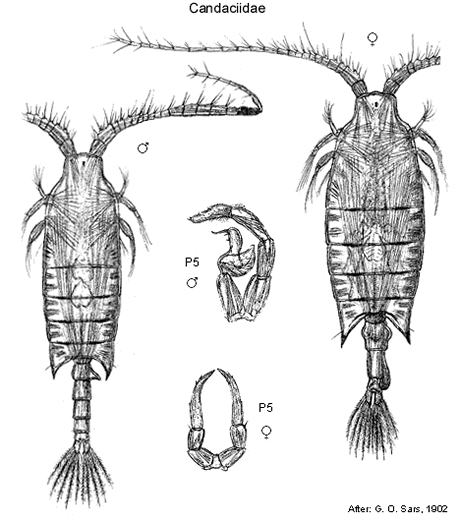 |
||||||
|
|
|
|
|
|
Calanoidea: FamiliesJ.M. Bradford-GrieveCandaciidae Giesbrecht, 1892
Description. Female. Anterior head in dorsal view rectangular. Rostrum without filaments; rostral margin extends into 2 blunt protrusions, or not extended. Cephalosome and pedigerous somite 1 separate; pedigerous somites 4 and 5 separate. Posterior corners of prosome in lateral view bluntly rounded, or with 1 acute point, or triangular or obtusely pointed; dorsal view symmetrical. Urosome with 3 free somites. Genital double-somite asymmetrical in dorsal view; gonopores close together and totally covered by single genital operculum; without seminal receptacles. Caudal rami symmetrical. Mouthparts. Antenna 1 with 24 free segments; ancestral segments X and XI separate. Antenna 2 exopod with 7 free segments; 7-8 setae; with 2 terminal setae; basis and endopod fused. Mandible basis without setae; endopod terminal segment with 6 setae. Maxilla 1 basal exite seta absent; exopod extends short of endopod distal border. Maxilla 2 coxal epipodite seta absent; endopod setae claw-like. Maxilliped coxal endite 2 with 1 seta. Legs. Leg 1 basis inner distal seta absent; outer seta present; endopod with 2 segments; exopod with 3 segments; exopod segment 1 with outer distal spine; exopod segment 3 with 4 inner setae. Leg 2 endopod with 2 segments; exopod with 3 segments; exopod segment 3 with 3 outer spines. Leg 3 basis outer distal spine absent. Legs 3 and 4 endopod with 2 segments; exopod with 3 segments; exopod segment 3 with 3 outer spines; exopod segment 3 with 5 inner setae. Legs 2-4 surfaces naked; terminal spine with outer border serrated. Leg 5 present; very dissimilar from legs 2-4; coxa inner border without seta; uniramous, not natatory, usually symmetrical; coxae and intercoxal sclerite fused; basis with 1 outer seta; exopod 1-segmented, long, may end in 1 or more spine-like processes, a finger-like process, or a single long seta; setae may or may not be present in the inner margins. Mode of life. Pelagic, in oceanic waters. Depth distribution. Epipelagic (0-500 m), or mesopelagic (500-1000 m). Generic composition. This family contains two genera Candacia Dana, 1846; Paracandacia Grice, 1963.
(Variant) Male (sexually dimorphic characters). Description. Male. Pedigerous somites 4 and 5 fused or partly fused. Posterior corners of prosome in lateral view bluntly rounded, or with 1 acute point; dorsal view asymmetrical. Urosome symmetrical in dorsal view, or asymmetrical in dorsal view. Mouthparts. Mouthparts well-developed. Antenna 1 geniculate on right. Maxilliped endopod segments 5 and 6 with outer setae normal. Legs. Right leg 5 uniramous; exopod short, 2-segmented, usually set in opposition to long, wide, terminally rounded expansion of basis, in Paracandacia there is no such expansion and exopod segment 2 is terminated by long, plumose seta. Left leg 5 uniramous; exopod elongate, 2-segmented, segments narrow, terminal segment rounded distally, variously decorated with small outer border spines and rows of hairs.
Cite this publication as: 'Bradford-Grieve, J.M. (2002 onwards). Calanoida: families. Version 1: 2 October 2002. https://crustacea.net'. |
|
|
|
|
|
|
|
|
|
Copyright © Australian Museum, 2002 - 2003
Australian Museum website
